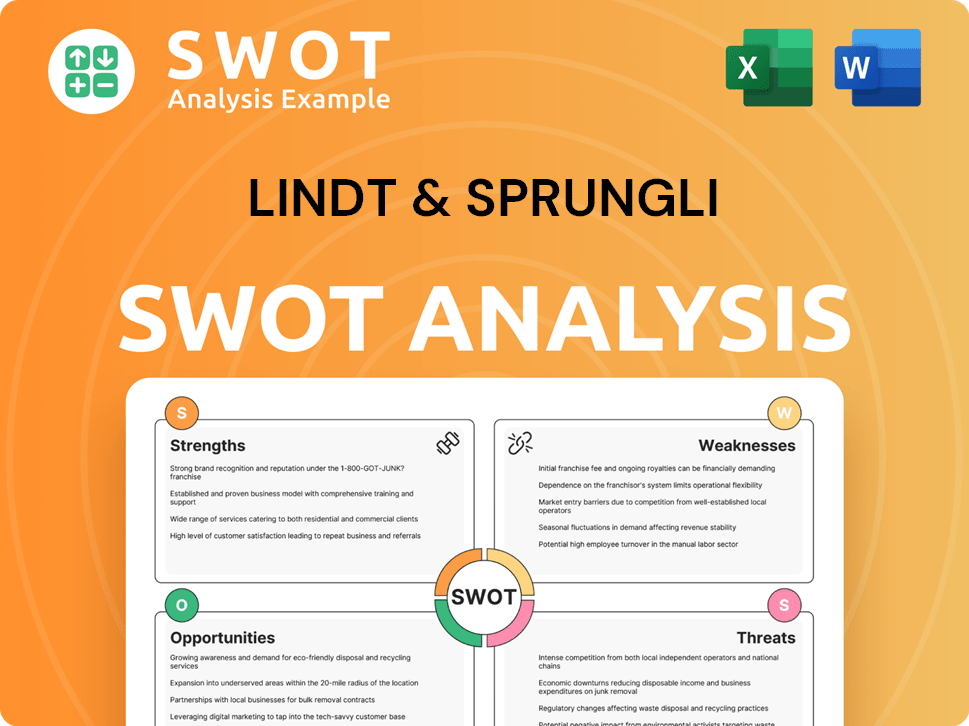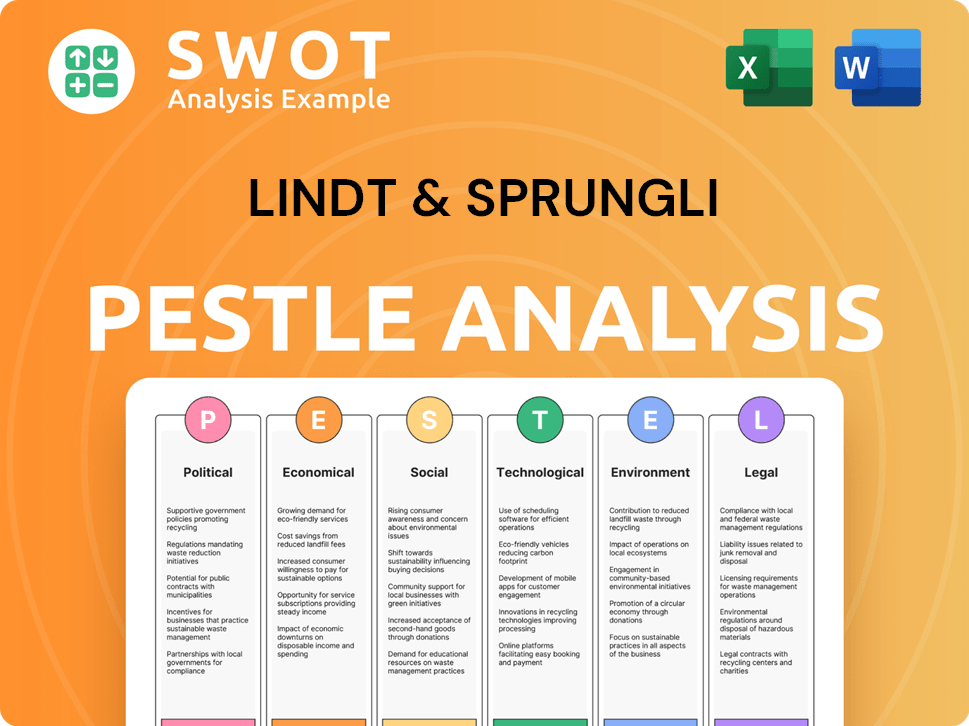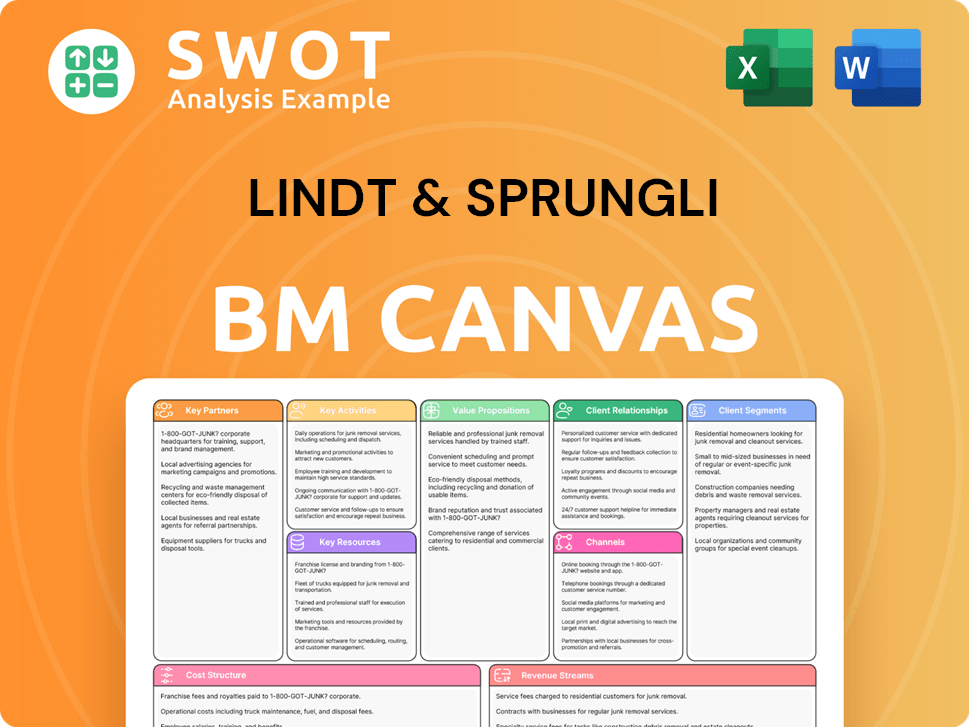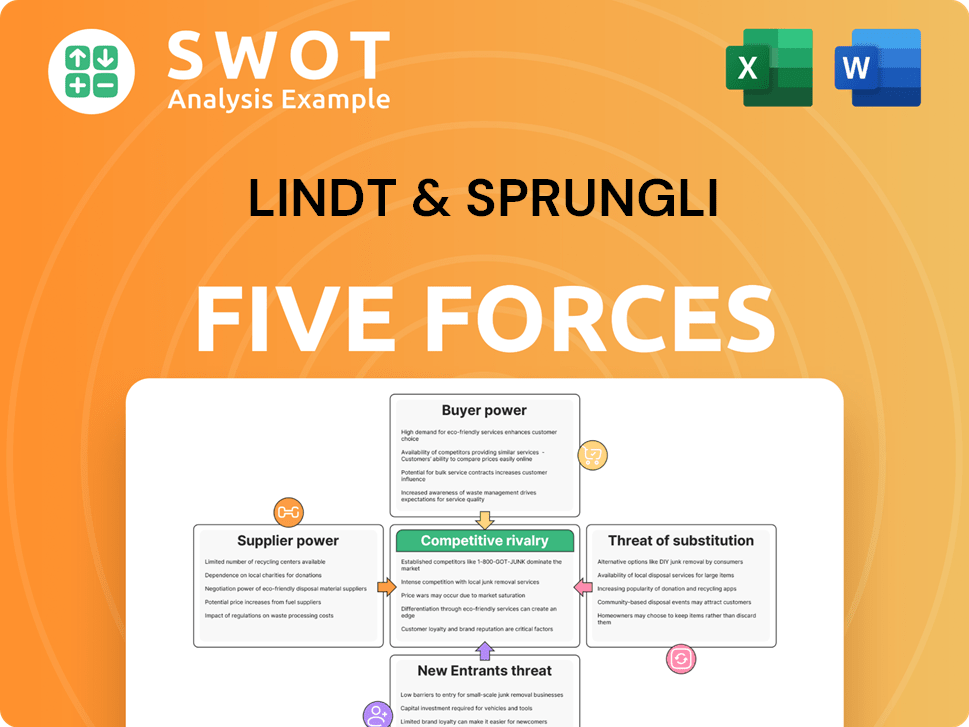Lindt & Sprungli Bundle
Who Really Calls the Shots at Lindt & Sprüngli?
Unraveling the ownership of a global chocolate giant like Lindt & Sprüngli is key to understanding its future. From its humble beginnings in 1845 as a small confectionery shop in Zurich, Switzerland, to its current status as a premium chocolate leader, the company's ownership structure has evolved significantly. This journey reveals how decisions are made and how the Lindt & Sprungli SWOT Analysis is impacted by those decisions.

Understanding the Lindt ownership structure is crucial for investors and chocolate enthusiasts alike. This exploration will delve into the Lindt history, tracing the company's evolution from its founders, David Sprüngli and Rudolf Sprüngli-Ammann, to its current stakeholders. We'll explore who owns Lindt chocolate company and how these ownership dynamics influence the Swiss chocolate maker's strategic direction and financial performance, including its impressive 2024 growth and annual revenue.
Who Founded Lindt & Sprungli?
The story of Lindt & Sprungli, a renowned name in the world of Swiss chocolate, began in 1836. David Sprüngli and his son, Rudolf Sprüngli-Ammann, laid the foundation for what would become a global chocolate empire by acquiring a small confectionery shop in Zurich. Their early ventures set the stage for the innovative chocolate production that would later define the company.
By 1845, the Sprünglis were already producing their own solid chocolate bars under the brand 'David Sprüngli & Son'. This early success led to significant growth, prompting them to move their production to a factory in Horgen in 1847. This expansion was a critical step in scaling up their operations to meet increasing demand and solidify their presence in the Swiss chocolate market.
The ownership structure underwent a significant change in 1892 when Rudolf Sprüngli-Ammann retired and split the business between his two sons. Johann Rudolf Sprüngli-Schifferli took control of the chocolate factory, which would become a key part of Lindt & Sprüngli. His brother, David Robert Sprüngli-Baud, received the confectionery stores in Zurich, which continue to operate today as Confiserie Sprüngli. This division marked the beginning of two independent enterprises.
David Sprüngli and his son, Rudolf, started with a confectionery shop in Zurich in 1836.
By 1845, they produced their own chocolate bars, and in 1847, moved to a factory in Horgen.
In 1892, Rudolf Sprüngli-Ammann divided the business between his sons.
Johann Rudolf Sprüngli-Schifferli converted the chocolate factory into 'Chocolat Sprüngli AG' in 1899.
Also in 1899, the company acquired Rodolphe Lindt's factory, including the conching process.
The company was renamed 'Aktiengesellschaft Vereinigte Berner und Zürcher Chocoladefabriken Lindt & Sprüngli' after the acquisition.
The early ownership of the Lindt chocolate company was primarily within the Sprüngli family. The acquisition of Rodolphe Lindt's factory was a pivotal moment.
- The acquisition of Rodolphe Lindt's factory for 1.5 million gold francs (approximately CHF 100 million today) was crucial.
- This included Lindt's secret conching process, which produced the renowned 'chocolat fondant'.
- The merger of Sprüngli's factory with Lindt's marked a strategic move to combine innovation and established practices.
- This laid the groundwork for what Lindt & Sprüngli is today, a leading Swiss chocolate enterprise.
Lindt & Sprungli SWOT Analysis
- Complete SWOT Breakdown
- Fully Customizable
- Editable in Excel & Word
- Professional Formatting
- Investor-Ready Format

How Has Lindt & Sprungli’s Ownership Changed Over Time?
The ownership structure of Lindt & Sprüngli has evolved significantly since its initial public offering (IPO) in 1986. This event was a pivotal moment, setting the stage for the company's international expansion and growth. The company is listed on the SIX Swiss Exchange, which has facilitated its access to capital and enabled its strategic moves in the global market. As of June 10, 2024, the total capital comprised CHF 23,023,520, divided into 134,099 registered shares with a par value of CHF 100 and 961,362 participation certificates with a par value of CHF 10.
Key stakeholders include institutional investors and foundations, which collectively shape the company's strategic direction. The presence of significant shareholders like the 'Fonds für Pensionsergänzungen der Chocoladefabriken Lindt & Sprüngli AG,' the 'Finanzierungsstiftung für die Vorsorgeeinrichtungen der Chocoladefabriken Lindt & Sprüngli AG,' the 'Lindt Cocoa Foundation,' and the 'Lindt Chocolate Competence Foundation' holding 20.61% of the share capital and voting rights as of December 31, 2021, highlights the importance of long-term commitment and stability. The Lindt Chocolate Competence Foundation's role is particularly crucial in safeguarding the company's legacy and core values. Ernst Tanner, along with his family, has also played a significant role in the company's global expansion.
| Stakeholder | Ownership Percentage (Approximate) | As of Date |
|---|---|---|
| Fonds für Pensionsergänzungen der Chocoladefabriken Lindt & Sprüngli AG, Finanzierungsstiftung für die Vorsorgeeinrichtungen der Chocoladefabriken Lindt & Sprüngli AG, Lindt Cocoa Foundation, Lindt Chocolate Competence Foundation | 20.61% | December 31, 2021 |
| Charles Schwab Investment Management, Inc. | 1.11436% | March 31, 2025 |
| BlackRock, Inc. | 4.46% | August 30, 2017 |
Major institutional investors such as Charles Schwab Investment Management, Inc., The Vanguard Group, Inc., BlackRock, Inc., Comgest S.A., and Schroder Investment Management North America Inc. hold substantial stakes in the company. As of March 31, 2025, Charles Schwab Investment Management, Inc. held 1.11436% of the company's total ownership, valued at CHF 278.78 million. These significant ownership positions have supported the company's strategy of maintaining its premium quality and expanding its global footprint. The company's ability to navigate challenging market conditions, such as the record-high cocoa costs in 2024, demonstrates the strength of its business model and the support of its key stakeholders. To learn more about the company's target audience, you can read the article about the Target Market of Lindt & Sprungli.
The ownership of Lindt & Sprüngli is a mix of institutional investors, foundations, and key individuals. The company's shares are traded on the SIX Swiss Exchange.
- Institutional investors hold significant stakes.
- Foundations play a role in preserving the company's legacy.
- The Tanner family is a prominent owner.
- The company went public in 1986.
Lindt & Sprungli PESTLE Analysis
- Covers All 6 PESTLE Categories
- No Research Needed – Save Hours of Work
- Built by Experts, Trusted by Consultants
- Instant Download, Ready to Use
- 100% Editable, Fully Customizable

Who Sits on Lindt & Sprungli’s Board?
The Board of Directors of Chocoladefabriken Lindt & Sprüngli AG oversees the company's management, strategy, and supervisory functions. Operational management is handled by the Executive Chairman, CEO, and Group Management.
As of April 16, 2025, at the 127th Ordinary Annual General Meeting, Ernst Tanner served as the Executive Chairman of the Board of Directors. The Board proposed a maximum aggregate compensation of CHF 3.2 million for its members for the period from the 2025 AGM to the 2026 AGM.
| Board Member | Role | Notes |
|---|---|---|
| Ernst Tanner | Executive Chairman | Chaired the 127th Ordinary Annual General Meeting on April 16, 2025. |
| Dieter Weisskopf | CEO | Handles operational management tasks. |
| Group Management Members | Various | Involved in operational management. |
The voting structure at Lindt & Sprüngli distinguishes between registered shares and participation certificates. Registered shares have voting rights, while participation certificates do not. At the Annual General Meeting on April 16, 2025, 104,371 votes were represented, which accounted for 90% of the registered share capital with voting rights. The proposal to approve the consolidated financial statements for 2024 passed with 98.3% 'YES' votes, and the compensation report for 2024 was approved with 86.2% 'YES' votes. For further insights into the competitive environment, explore the Competitors Landscape of Lindt & Sprungli.
The voting power at Lindt & Sprüngli is determined by registered shares. Participation certificates do not have voting rights. Registered shares held the voting power at the Annual General Meeting.
- Registered shares have voting rights.
- Participation certificates do not have voting rights.
- Resolutions are passed by an absolute majority of the votes represented.
- At the 2025 AGM, 104,371 votes were represented.
Lindt & Sprungli Business Model Canvas
- Complete 9-Block Business Model Canvas
- Effortlessly Communicate Your Business Strategy
- Investor-Ready BMC Format
- 100% Editable and Customizable
- Clear and Structured Layout

What Recent Changes Have Shaped Lindt & Sprungli’s Ownership Landscape?
In recent years, Lindt & Sprüngli has been active in share buyback programs. A significant program, initiated in August 2022 with a budget of CHF 1 billion, was completed in March 2024, with a total volume of CHF 997,801,400. Following this, a new buyback program for registered shares and participation certificates, valued at up to CHF 500 million, was launched in August 2024, and is scheduled to continue until at least July 31, 2026. By the end of December 2024, CHF 145 million had already been repurchased under this new program. These actions reflect the company's strategy regarding its ownership structure and financial management.
Leadership changes have also occurred. Rolf Fallegger retired from the Group Management at the end of June 2024. Ana Dominguez succeeded him, taking over responsibilities for the USA, Canada, and Mexico, along with Ghirardelli Chocolate Company and Russell Stover Chocolates, effective July 1, 2024. Furthermore, Marco became President & CEO of Lindt USA in 2024, and Monya was appointed Vice President, Human Resources at Lindt USA in January 2025. These changes signal adjustments in the management team and operational focus within the broader context of the Swiss chocolate market.
| Key Developments | Details | Timeline |
|---|---|---|
| Share Buyback Program 1 | Up to CHF 1 billion | August 2, 2022 - March 18, 2024 |
| Share Buyback Program 2 | Up to CHF 500 million | August 2, 2024 - July 31, 2026 (at least) |
| Leadership Transition | Rolf Fallegger retired, Ana Dominguez appointed | June/July 2024 |
The chocolate industry's trend towards premiumization is evident. In 2024, despite high cocoa costs, Lindt & Sprüngli increased prices by 6.3% and anticipates further double-digit price increases in 2025. The company aims for organic growth of 7% to 9% in 2025 and plans to open 30 to 40 new stores globally, along with increased brand support. These strategic moves underscore the company's commitment to growth and profitability, especially within the competitive Swiss chocolate and broader chocolate company landscapes.
The company has executed share buyback programs to manage its capital and potentially increase shareholder value, reflecting strategic financial planning.
Leadership transitions, such as the appointment of Ana Dominguez, indicate adjustments in strategic direction and operational focus within the organization.
Lindt & Sprüngli is focusing on premium products, as seen by its price increases and growth in value despite rising cocoa costs, aligning with consumer preferences.
The company anticipates continued growth and profitability, with plans for store openings and enhanced brand support to maintain its market position.
Lindt & Sprungli Porter's Five Forces Analysis
- Covers All 5 Competitive Forces in Detail
- Structured for Consultants, Students, and Founders
- 100% Editable in Microsoft Word & Excel
- Instant Digital Download – Use Immediately
- Compatible with Mac & PC – Fully Unlocked

Related Blogs
- What are Mission Vision & Core Values of Lindt & Sprungli Company?
- What is Competitive Landscape of Lindt & Sprungli Company?
- What is Growth Strategy and Future Prospects of Lindt & Sprungli Company?
- How Does Lindt & Sprungli Company Work?
- What is Sales and Marketing Strategy of Lindt & Sprungli Company?
- What is Brief History of Lindt & Sprungli Company?
- What is Customer Demographics and Target Market of Lindt & Sprungli Company?
Disclaimer
All information, articles, and product details provided on this website are for general informational and educational purposes only. We do not claim any ownership over, nor do we intend to infringe upon, any trademarks, copyrights, logos, brand names, or other intellectual property mentioned or depicted on this site. Such intellectual property remains the property of its respective owners, and any references here are made solely for identification or informational purposes, without implying any affiliation, endorsement, or partnership.
We make no representations or warranties, express or implied, regarding the accuracy, completeness, or suitability of any content or products presented. Nothing on this website should be construed as legal, tax, investment, financial, medical, or other professional advice. In addition, no part of this site—including articles or product references—constitutes a solicitation, recommendation, endorsement, advertisement, or offer to buy or sell any securities, franchises, or other financial instruments, particularly in jurisdictions where such activity would be unlawful.
All content is of a general nature and may not address the specific circumstances of any individual or entity. It is not a substitute for professional advice or services. Any actions you take based on the information provided here are strictly at your own risk. You accept full responsibility for any decisions or outcomes arising from your use of this website and agree to release us from any liability in connection with your use of, or reliance upon, the content or products found herein.